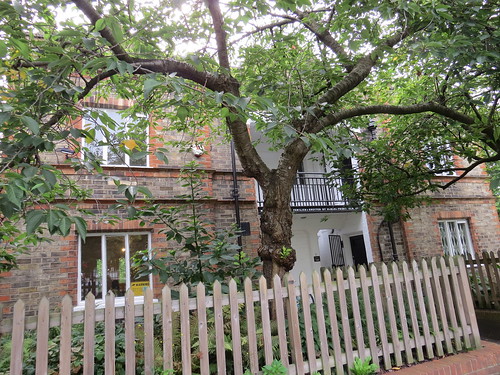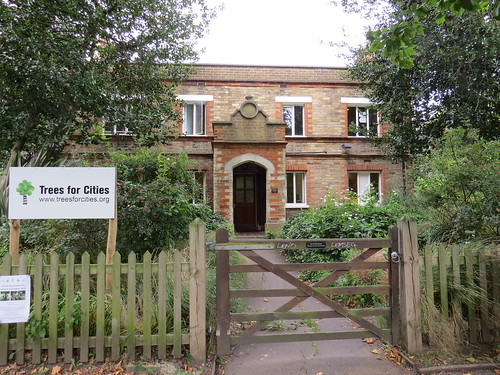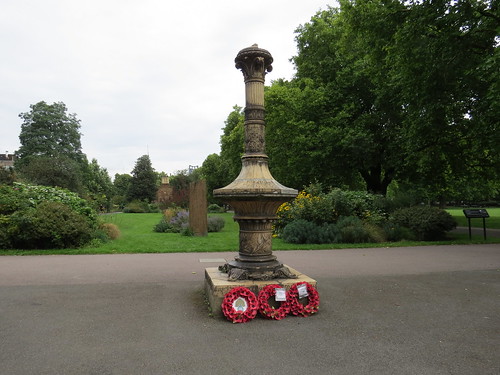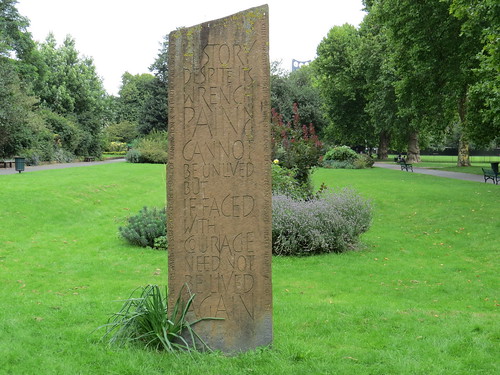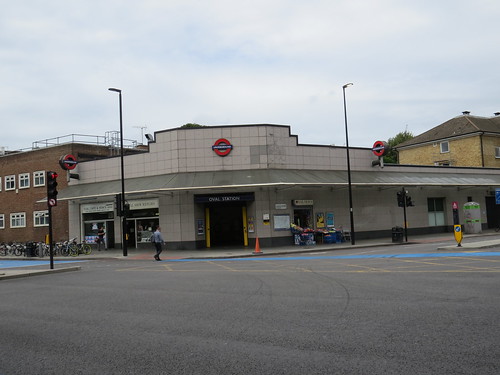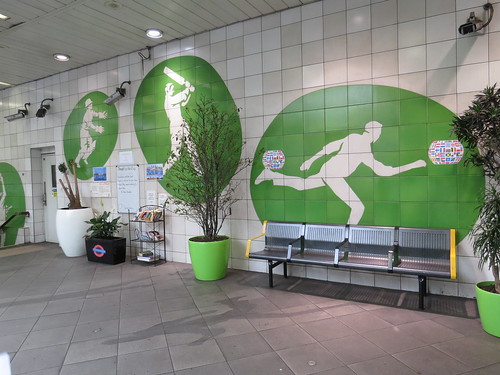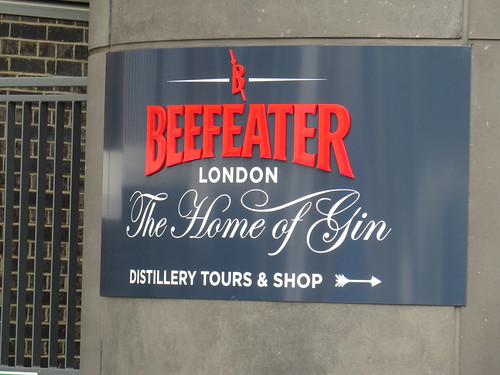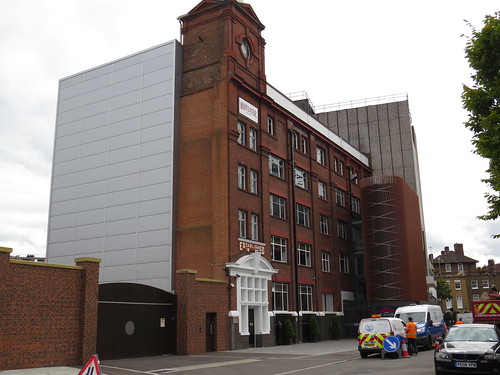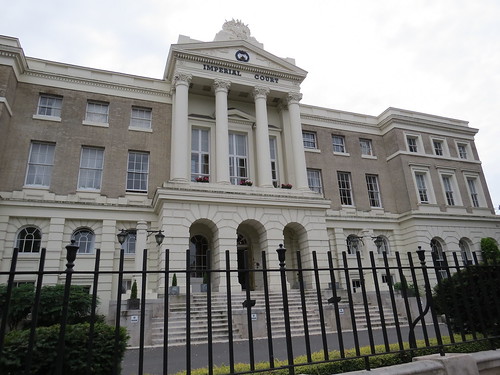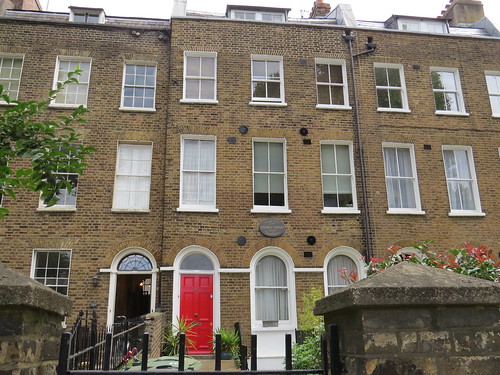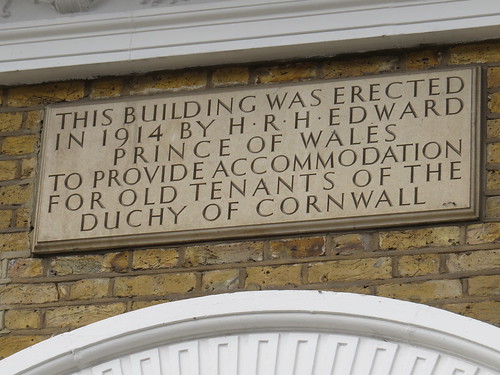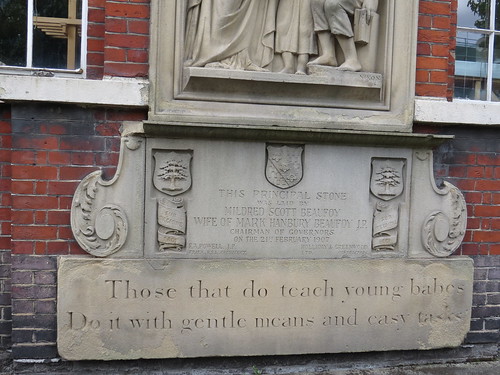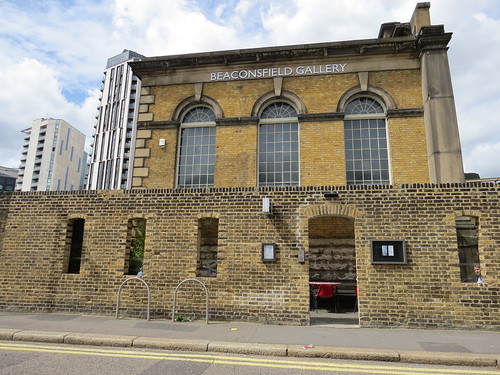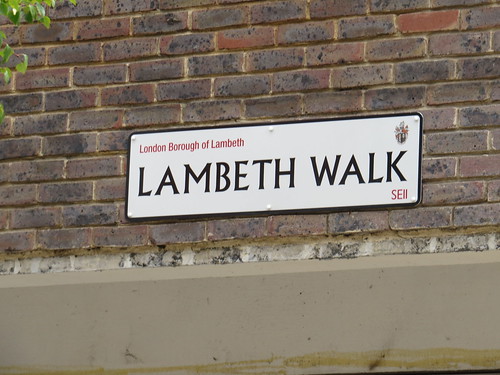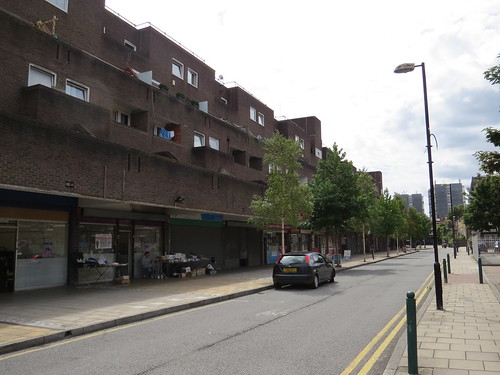SE11 is Kennington – and Lambeth. This is an area which does not seem to have a proper centre of any kind, but of course there are still plenty of interesting things here. We start our walk at Kennington Post Office which is at 410 Kennington Road.
Turn right out of the Post Office and our first stop is just down the road ahead of you.
Stop 1: Kennington Park
Kennington Park dates from 1854 and is on the site of what had been Kennington Common. The Common was a place for mass gatherings and public speaking, and until 1800 was also a site of public executions . The Common was enclosed and was made a public park in the early 1850s by the Government.
There is an interesting looking building ahead from Kennington Road as it meets Kennington Park Road, which we will go to first..
According to architectural guru Pevsner, this building started life as a pair of cottages put up for the 1851 Great Exhibition by special request of Prince Albert to set an example of what working class housing should be like
Pevsner describes the detail as “minimum Elizabethan” with a plan that “has the staircase in a niche in the centre, a motif to become almost standard for mid Victorian cheap flats.”
The cottage was rebuilt here in 1852 to house park attendants. Later it was occupied by the park superintendent but since 2003 it has been the headquarters of the charity, Trees for Cities.
Now go into the park and head to the right. You will come across a column. This is all that is left of a fountain designed by a man called George Tinworth (1843 – 1913), who was a local lad and who became a major designer for the Royal Doulton ceramics company based nearby.
It even has a little Doulton Lambeth stamp on the base.
The fountain was given by Sir Henry Doulton in 1869 and originally included a group of people in medieval dress. Sadly the fountain was severely damaged by a bomb in the Second World War and this is all that is left.
Doulton’s Lambeth factories were towards the river and were also badly damaged in air raids during the second world war. They closed completely in 1956 due to clean air regulations in London and the work was transferred to Staffordshire.
Nearby is a memorial to those who died as a result of a bomb directly hitting an underground shelter in the park in October 1940.
The memorial was designed by sculptor Richard Kindersley and is a slab of Caithness stone. It says: “To commemorate the wartime suffering of the people of Kennington and in particular over 50 men, women and children who were killed on 15 October 1940 when a bomb destroyed an air-raid shelter near this spot. Rest in peace.”
There is also a quotation from poet Maya Angelou: “History despite its wrenching pain cannot be unlived but if faced with courage need not be lived again.”
If you keep walking into the park, you will come to another interesting object – this time it is part of a.drinking water fountain, given by one Felix Slade.
Felix Slade (1788 – 1868), was an English lawyer and collector of glass, books and engravings whose name lives on because he endowed three Slade Professorships of Fine Art ( at Oxford University, Cambridge University, and University College London), Slade apparently donated this drinking water fountain in 1862 after feeling sorry for the local children who, after playing in the gymnasium, had been taking water from a cab horse trough.
Exit the Park at its southern end and you will be almost opposite Oval tube station
Stop 2 Oval Station
Hard to believe from looking at the station now but this is one of the oldest deep level stations on the Underground. There has been a station here since 1890.
However it has been considerably rebuilt since then, not least to replace the lifts with escalators. And more recently to gain a tile mural relating to cricket.
Now head as if you have turned left out of the station and ahead you will see our next stop.
Stop 3: Oval Cricket Ground
This is of course the famous cricket ground and home ground of Surrey County Cricket Club since it was opened in 1845.
In addition to cricket, The Oval has seen a number of other historically significant sporting events. In 1870, it staged England’s first international football match, versus Scotland. It hosted the first FA Cup final in 1872,as well as those between 1874 and 1892. In 1876, it held both the England v Wales and England v Scotland rugby international matches, and in 1877, rugby’s first Varsity match.
The end of the ground nearest to Oval station is called the Pavilion end, because it is the location of the Members’ Pavilion. The other end is called the Vauxhall end, which not surprisingly is at the end of the ground nearest Vauxhall.
At the Pavilion end there are these gates, called the Hobbs gates, named after Jack Hobbs (Sir John Hobbs 1882 – 1963), a leading batsman for Surrey and England from the first part of the 20th century.
And just to one side of the gates is a plaque to commemorate the first Test Match on English soil which was between England and Australia in 1880.
This was not the first test match which was a couple of years earlier in Melbourne, Australia. Nor was it the first match where the term “The Ashes” was used which was slightly later.
In 1882, Australia won the Test at the Oval by seven runs within two days. This was widely seen as a humiliation for English cricket and led to the Sporting Times printing an obituary notice for English cricket in mocking terms. This led to the creation of the Ashes trophy, which is still contested by England and Australia.
Now head to the right of the ground. Note by the way that the streets that go either way around the cricket ground are actually called Kennington Oval.
Then take the second side street on the right – called Clayton Street. At the end turn left and you will see our next stop immediately ahead of you, an area once known as Kennington Green but which today is green only in so far as the hoardings.
Stop 4: Work site for Northern Line extension
This is one of two sites in Kennington which are being used to build the extension of the Northern Line to Battersea – the other one being at the north end of Kennington Park.
Below our feet here is the loop line which allows Charing Cross trains to turn round at Kennington without reversing. And somewhere around here the new line coming from Battersea will be tied into the loop. The other junction to enable trains to go to Battersea is near the other work site in the park.
Regular users of the Northern line will know that most trains via Bank tend to go all the way to Morden and that Charing Cross trains usually terminate at Kennington. This is because the Bank route was built first – this section originally built in 1890 and the Charing Cross branch was created later in the 1920s by extending the Charing Cross, Euston and Hampstead Railway southwards from Charing Cross. In doing this the Charing Cross branch was given a reversing loop, as previously mentioned. But the Bank branch did not get any special turning arrangement other than a crossover between the running tunnels. As a result it has always been easier and less disruptive to other services to turn Charing Cross branch trains at Kennington as compared to Bank branch trains.
The arrival of the Battersea extension in 2020 will probably lead to the formal splitting of the Northern Line into two lines. In practice this will happen at the southern end even if they do not change the line name. But changing the arrangements for the Edgware and High Barnet branches so they cease to get a choice of Bank and Charing Cross trains will probably have to wait until Camden Town station is rebuilt.
Then there is the interesting question about what happens with the Night Tube which only runs on the Charing Cross branch but which serves all the station to Morden. Maybe they will start running the night tube to Battersea on the Charing Cross branch and introduce Night Tube services on the Bank branch to serve stations south of Kennington..
Now go down this side street and follow it round (it is called Montford Place). Soon ahead you will see a gasometer and to the right a factory.
Quite a surprise to find a factory here, especially one that is still producing something – and that something is called gin.
Stop 5: Beefeater Gin Distillery
Follow the factory site round and you get to the visitor attraction and its inevitable shop selling all manner of gin related items.
This is I think the only remaining “old school” gin maker left on its original site in London – the likes of Gordons, Gilbey and Nicholsons having long closed. Of course now there are lots of new “boutique” gin makers, like Sipsmiths, City of London and Portobello Road. They may have the fancy flavourings but they do not have the “heritage”.
Keep going and looking back you will get this better view of the premises
Strange to think there were many such works in inner London but this is one of the rare survivors where the building is still in use for its original purpose.
Go to the end of the road and turn right into Kennington Lane. Our next stop is just on the right.
Stop 6: Imperial Court
Guarded by railings to keep the riff raff out, this grand building is called Imperial Court
It was built as the Licensed Victuallers’ School and dates from 1836.
Later it became the headquarters of the Navy, Army and Air Forces Institutes (NAAFI) which provides recreational establishments for British Armed Forces, and sells goods to servicemen and their families. The NAAFI was created in 1921 and it still exists today. Its website explains:
“NAAFI was created by the British Government in 1921 when the Expeditionary Force Canteens and the Navy and Army Canteen Board were combined to run the recreational establishments needed by the Armed Forces, and to sell goods to servicemen and their families
NAAFI expanded its operation over the next 17 years, supporting military bases and deployments across the world, from Bermuda and Jamaica, to Singapore and China. At the outbreak of WWII NAAFI grew exponentially to support the troops on active service, with the number of employees rising from 8,000 to a peak of 110,000 and the number of trading outlets growing from 1,350 to nearly 10,000.
Post war, NAAFI rescaled its operations, closing canteens at a rate of 200 per week and the number of employees reducing to 65,000 by 1947. From the 1950’s onwards, NAAFI has supported the British Forces at home and abroad, including the conflicts in The Falklands, the two Gulf Wars and Afghanistan amongst many others. Today NAAFI operates in far fewer locations but is present in Germany, Gibraltar, Northern Ireland, Brunei, the South Atlantic Islands and on board HM Ships. With around 100 outlets, NAAFI still provides convenience and a ‘taste of home’ to our Forces and their families overseas.”
NAAFI moved out in 1992 and the building has been converted into (yes you guessed) flats.
Keep going along Kennington Lane and you will reach Kennington Road which slices across at an angle turn left here and our next stop is just on the right hand side near the junction.
Stop 7: Number 287 Kennington Road
The building with the red door is one a number of places where the young Charlie Chaplin lived in this area.
Chaplin (1889 – 1977) was of course a world famous comedy actor who is most remembered as an icon of the Silent Era. He is instantly recognisable as the Tramp, with his bowler hat, funny walk, moustache and cane. There is a nice piece here about the local connections in this blog from my fellow Footprints guide Michael.
http://footprintsoflondon.com/2017/03/charlie-chaplins-kennington/
He lived here as a child in 1898. The family moved about a bit so In fact there are a number of plaques to Chaplin in this area – including 39 Methley Street SE11 just round the corner from here and Glenshaw Mansions, Brixton Road SW9 which is just the other side of Oval station. and East Street, just off Walworth Road, SE17.
Our next stop is just over the road.
Stop 8: former Granada cinema
Here on the corner of Kennington Road and Black Prince Road once stood a cinema.
According to the wonderful Cinema Treasures site, this was built as the Regal Cinema and opened in November 1937. It was built for and operated by an independent operator, Arthur O’Connor Cinemas but was taken over by the Granada chain in May 1948. It was renamed Granada in January 1949 and closed as a cinema in July 1961.
It became a Bingo Hall in October 1961 which lasted to March 1997. Then the building was used by a church for a few years to about 2003.
The auditorium was demolished in 2004 and a block of flats was on the site. The original cinema entrance and facade was retained and the ground floor now houses a Tesco Express store.
I am not sure why they bothered. It is so badly done. The old entrance to the cinema is blocked off rather than being made a feature and the entrance to the Tesco is tucked away and not really very easy to spot.
Now head down Black Prince Road. Our next stop is the development at the corner of Newburn Street.
Stop 9: Woodstock Court
This rather elegant development belongs to the Duchy of Cornwall, like quite of bit of property hereabouts, including the Oval Cricket Ground.
The Duchy of Cornwall historically belongs to the eldest son of the reigning British monarch, along with the title, Duke of Cornwall. However he does not “own” Duchy property outright and may not sell the assets for personal benefit. If the monarch has no male children, the rights and responsibilities of the duchy belong to The Crown and there is no duke. But that does not look like happening for a while yet.
This development dates from 1914 as you can see if you go down the side street.
Now look through the arch and you will see this idyllic view.
It is hard to believe you are almost in central London.
Return to Black Prince Road and turn left. Our next stop is a short way on the left.
Stop 10: The former Beaufoy Institute
Here on the left is an attractive building which has been the Diamond Way Buddhist centre since 2014.
This is Grade II listed and was built as the Beaufoy Institute, a boys technical college, in 1907. On the left section also has a relief panel moved from the original 1850s building with an image of a teacher and two pupils, beneath which is a plaque celebrating the laying of the foundation stone of the 1907 building,
The inscription reads, ‘Those that do teach our babes/Do it with gentle means and easy tasks’.”
You may recall the Beaufoy name from SW8 as they were the family behind the Vinegar works on South Lambeth Road.
More info on this building at: https://historicengland.org.uk/listing/the-list/list-entry/1358193
As you go along Black Prince Road you will see a railway bridge ahead of you – and the Doulton building – this is the last remnant of their Lambeth factories.
Sadly this is actually over the border in SE1 so we will not be going there!
Instead take a right into Newport Street.
Stop 11: Beaconsfield gallery
How strange to find a gallery here.
The Beaconsfield Gallery was founded in 1994 by artists Naomi Siderfin, David Crawforth and Angus Neill with the aim of “providing a streamlined resource for the development and presentation of contemporary art and a desire to “fill a niche between the institution, the commercial and the ‘alternative’.”
Beaconsfield occupies a building which was the southern wing of the former Lambeth Ragged School, so called because of the appearance of the children who attended. It was established between 1849 and 1851 by Henry Beaufoy. Most of the school was demolished in around 1903 to allow for the widening of the nearby railway, but this bit survived in railway ownership. And the school moved and became the Beaufoy Institute.
I was intrigued to know where the gallery name came from. It did not seem to be named after a local street, so maybe there was a connection with a person called Beaconsfield. But no. The Gallery website explains the place aims to “offer a space for artists and audiences to experience high quality (hence ‘beacon’), challenging, new artworks in a wide range (hence ‘field’) of contemporary visual art media through commissions, group exhibitions, performances, publications and events.”
Now head along and do a twiddle down what looks like a service yard to the right. This will lead you to our next stop.
Stop 12: Lambeth Walk
“Lambeth you’ve never seen,
The skies ain’t blue, the grass ain’t green.
It hasn’t got the Mayfair touch,
But that don’t matter very much.
We play the Lambeth way,
Not like you but a bit more gay
And when we have a bit of fun
Oh, Boy.
Anytime you’re Lambeth way
Any evening, any day,
You’ll find us all doin’ the Lambeth walk”
I bet you will now have that song going round in your head. This is the song “Lambeth Walk” from the musical “Me and My Girl” which had music by Noel Gay and its original book and lyrics by Douglas Furber and L. Arthur Rose. Originally dating from 1937, it was rewritten mainly by Stephen Fry, no less, and had an eight year year run in the West End from 1985. It was also successful on Broadway, winning three Tony awards.
There are some rather naff murals here including one celebrating the Lambeth Walk.
Here should you want to be reminded, is a video.
Sadly the real Lambeth Walk is a depressing redeveloped street that looks like this.
I dimly recall this from when I worked by Lambeth Bridge in the 1970s and this was new. I had the feeling that the shops were on both sides of the road and it was pedestrianised but maybe my mind is playing tricks on me.
However there is a newish looking building opposite the shopping parade.
So it is possible the area was re-redeveloped. Note the name of the building – Lupino Court. I can only assume this references Lupino Lane (1892 – 1959), He is best known for playing the lead role in Me and My Girl originally on stage and on film.
We are now at the end of our SE11 walk. from here, you can return to Black Prince Road, go under the railway, past the old Doulton Building (which is actually in SE1) and then onto Albert Embankment for buses or else a bit of a hike down to Vauxhall stations.
Post script
I should mention there was one place I did not get to in SE11 – the Cinema Museum, at 2 Dugard Way SE11 4TH is devoted to keeping alive the spirit of cinema from the days before the multiplex. It is located in the former Lambeth Workhouse which at one time was home to the destitute mother of Charlie Chaplin and her son.


